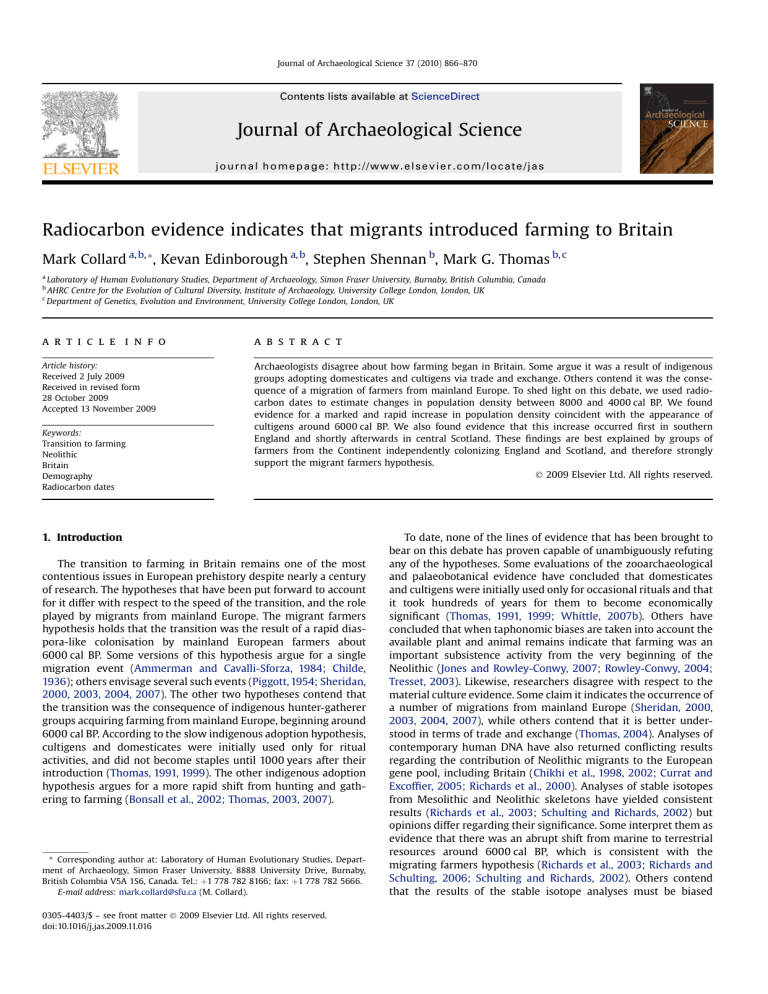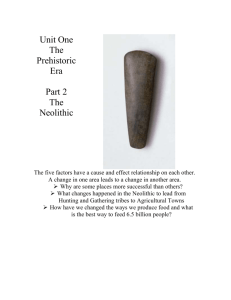Radiocarbon evidence indicates that migrants introduced farming to Britain Mark Collard ,

Journal of Archaeological Science 37 (2010) 866–870
Contents lists available at ScienceDirect
Journal of Archaeological Science
j o u r n a l h o m e p a g e : h t t p : / / w w w . e l s e v i e r . c o m / l o c a t e / j a s
Radiocarbon evidence indicates that migrants introduced farming to Britain
Mark Collard
,
,
, Kevan Edinborough
,
, Stephen Shennan
, Mark G. Thomas
a
Laboratory of Human Evolutionary Studies, Department of Archaeology, Simon Fraser University, Burnaby, British Columbia, Canada b
AHRC Centre for the Evolution of Cultural Diversity, Institute of Archaeology, University College London, London, UK c
Department of Genetics, Evolution and Environment, University College London, London, UK a r t i c l e i n f o
Article history:
Received 2 July 2009
Received in revised form
28 October 2009
Accepted 13 November 2009
Keywords:
Transition to farming
Neolithic
Britain
Demography
Radiocarbon dates a b s t r a c t
Archaeologists disagree about how farming began in Britain. Some argue it was a result of indigenous groups adopting domesticates and cultigens via trade and exchange. Others contend it was the consequence of a migration of farmers from mainland Europe. To shed light on this debate, we used radiocarbon dates to estimate changes in population density between 8000 and 4000 cal BP. We found evidence for a marked and rapid increase in population density coincident with the appearance of cultigens around 6000 cal BP. We also found evidence that this increase occurred first in southern
England and shortly afterwards in central Scotland. These findings are best explained by groups of farmers from the Continent independently colonizing England and Scotland, and therefore strongly support the migrant farmers hypothesis.
Ó 2009 Elsevier Ltd. All rights reserved.
1. Introduction
The transition to farming in Britain remains one of the most contentious issues in European prehistory despite nearly a century of research. The hypotheses that have been put forward to account for it differ with respect to the speed of the transition, and the role played by migrants from mainland Europe. The migrant farmers hypothesis holds that the transition was the result of a rapid diaspora-like colonisation by mainland European farmers about
6000 cal BP. Some versions of this hypothesis argue for a single
migration event ( Ammerman and Cavalli-Sforza, 1984; Childe,
1936 ); others envisage several such events (
). The other two hypotheses contend that the transition was the consequence of indigenous hunter-gatherer groups acquiring farming from mainland Europe, beginning around
6000 cal BP. According to the slow indigenous adoption hypothesis, cultigens and domesticates were initially used only for ritual activities, and did not become staples until 1000 years after their
introduction ( Thomas, 1991, 1999 ). The other indigenous adoption
hypothesis argues for a more rapid shift from hunting and gath-
ering to farming ( Bonsall et al., 2002; Thomas, 2003, 2007
).
* Corresponding author at: Laboratory of Human Evolutionary Studies, Department of Archaeology, Simon Fraser University, 8888 University Drive, Burnaby,
British Columbia V5A 1S6, Canada. Tel.: þ 1 778 782 8166; fax: þ 1 778 782 5666.
E-mail address: mark.collard@sfu.ca
(M. Collard).
0305-4403/$ – see front matter Ó 2009 Elsevier Ltd. All rights reserved.
doi:10.1016/j.jas.2009.11.016
To date, none of the lines of evidence that has been brought to bear on this debate has proven capable of unambiguously refuting any of the hypotheses. Some evaluations of the zooarchaeological and palaeobotanical evidence have concluded that domesticates and cultigens were initially used only for occasional rituals and that it took hundreds of years for them to become economically significant (
Thomas, 1991, 1999; Whittle, 2007b
). Others have concluded that when taphonomic biases are taken into account the available plant and animal remains indicate that farming was an important subsistence activity from the very beginning of the
Neolithic ( Jones and Rowley-Conwy, 2007; Rowley-Conwy, 2004;
Tresset, 2003 ). Likewise, researchers disagree with respect to the
material culture evidence. Some claim it indicates the occurrence of a number of migrations from mainland Europe (
), while others contend that it is better understood in terms of trade and exchange (
contemporary human DNA have also returned conflicting results regarding the contribution of Neolithic migrants to the European gene pool, including Britain (
Chikhi et al., 1998, 2002; Currat and
Excoffier, 2005; Richards et al., 2000
). Analyses of stable isotopes from Mesolithic and Neolithic skeletons have yielded consistent
results ( Richards et al., 2003; Schulting and Richards, 2002
) but opinions differ regarding their significance. Some interpret them as evidence that there was an abrupt shift from marine to terrestrial resources around 6000 cal BP, which is consistent with the migrating farmers hypothesis (
Richards et al., 2003; Richards and
Schulting, 2006; Schulting and Richards, 2002
). Others contend that the results of the stable isotope analyses must be biased
M. Collard et al. / Journal of Archaeological Science 37 (2010) 866–870 because there is zooarchaeological evidence that use of marine foods continued into the Neolithic (
isotope data demonstrate a rapid shift in diet on the grounds that most of the Neolithic skeletons from which the data were obtained
post-date the start of the Neolithic by ca. 200 years ( Whittle,
2. Timing and rate of the Neolithic demographic transition
In an effort to move the debate forward, we used
14
C date densities as a guide to changes in the size of the human population of Britain between 8000 and 4000 cal BP. Ethnographic data indicate that, with the exception of certain coastal and riparian areas where rich aquatic resources are available, farming usually supports much higher population densities in temperate regions than hunting and gathering (
). Consistent with this, analyses of cemetery samples have found that an increase in population occurred in conjunction with the transition to farming in many parts of mainland Europe and also in parts of North America
( Bocquet-Appel, 2002, 2008; Bocquet-Appel and Naji, 2006
).
Accordingly, we reasoned that the timing and rate of change in population size should be informative regarding which of the hypotheses is most likely to be correct. The approach we employed has been used on a number of occasions recently to address questions regarding prehistoric demography (
2008; Collard et al., 2008; Erlandson et al., 2001; Gamble et al.,
2004, 2005; Gkiasta et al., 2003; Niekus, 2009; Shennan and
). Its rationale is that, because the number of site phases in a given time period can be expected to relate monotonically to population size, changes in summed probability distributions of calibrated
14
C dates derived from different site phases serve as a proxy for changes in population size. To date, the method has been used exclusively to reconstruct relative population size, but in principle it can also be used to reconstruct absolute population size if the summed probability distribution can be anchored to a known value for population size.
Details of
14
C dates from site phases classified as Mesolithic,
Neolithic or Bronze Age were obtained from the Archaeology Data
Service, Department of Archaeology, University of York. The dataset was then updated via searches of traditional published media and the grey literature. Our approach to date selection was conservative. The only dates not included in the dataset were ones deemed invalid by the originating laboratory. Dates claimed to be invalid on the basis of apparent stratigraphic inconsistency were included. We also included dates with large standard errors. This approach is conservative because the inclusion of residual and imprecise dates can be expected to diminish any differences between the Mesolithic and Neolithic in terms of inferred population size. A total of
4246
14
C dates from 1762 site phases were included in the dataset.
We began by calibrating the full set of dates and controlling for variation in dating intensity among site phases. The latter was accomplished by summing all the calibrated date curves for a given site phase and adjusting the area under the summed curve to equal one. Thus, for any given site phase we obtained an averaged date probability distribution equal in weight to any other site phase.
Next, we generated two summed probability distributions, one for all the dating intensity-corrected dates and one for 76 dates pertaining to the early use of cereal grains recently reported by
(2007) . Thereafter, we compared the two summed probability
distributions to determine whether the appearance of cultigens preceded the anticipated increase in population density by more than 1000 years, as the slow indigenous adoption hypothesis avers, or whether population growth closely followed the appearance of cultigens, as the migrant farmers and rapid indigenous adoption
867 hypotheses contend. Lastly, we repeated the analysis after removing the 2117 dates associated with high visibility Neolithic sites (e.g. barrows, cists, henges, causewayed enclosures and quarries), which we reasoned might bias the results in favour of an abrupt Mesolithic–Neolithic transition. We did not control for the effects of sea level change because recent work suggests that by
8000 cal BP the coastline of Britain was similar to what it is today
(
). The dates were calibrated in CALIB 5.0.1
(
Stuiver and Reimer, 1993 ) with the IntCal04 calibration curve
(
Reimer et al., 2004 ). We selected the latter on the grounds that it is
the most widely used calibration curve and is free of anomalies in the section relevant to the transition to farming in Britain. The calibrated date probability curves were summed using routines written in the programming language Python ( http://www.python.
org/ ) and plotted using the statistical analysis software environment ‘R’ ( http://www.r-project.org/ ).
The summed probability distribution obtained from the cereal grain-related dates indicates that farming arrived in Britain around
6000 cal BP ( Fig. 1 , green curve). The summed probability distri-
bution derived from the one-date-per-site phase set of dates suggests that population size was low until about 6000 cal BP
(
Fig. 1 , black curve). Between 6000 and 5610 cal BP there was
a sharp increase in population size. This was followed by a decrease that lasted until about 4400 cal BP. After 4400 cal BP, population size increased again. Removing dates from highly visible Neolithic sites eliminated the increase that begins at approximately 4400 cal
BP, but did not affect the increase that began around 6000 cal BP
(
Fig. 1 , red curve). Thus, the summed probability distributions
indicate that there was a rapid increase in the size of the population of Britain coincident with the arrival of domesticated plants. This is inconsistent with the slow indigenous adoption hypothesis.
To determine which of the other two hypotheses is best supported by the
14
C data, we calculated the annual growth rate during the growth phase between 6000 and 5610 cal BP with the formula for exponential growth: r ¼ ln ½ N t
= N
0
= t where N
0 is the size of the population at the start of growth and N t is the size of the population at time t later. Recent skeletal samplebased demographic work suggests that early Neolithic farmers in mainland Europe increased, on average, at a rate of 0.1–0.2% per year, and that this was considerably faster than the preceding
Mesolithic hunter-gatherers (
Bocquet-Appel, 2008 ). British hunter-
gatherers attempting to adopt farming would have faced a much steeper learning curve than farmers migrating from continental
Europe. Accordingly, the rapid indigenous adoption model predicts an annual growth rate below 0.1–0.2%, while the migrant farmers hypothesis predicts an annual growth rate equal to or d if the size of the migrating population was large d above 0.1–0.2%. The average
Fig. 1.
Summed probability distributions for the full set of dates, non-monument dates and cereal grain dates.
868 M. Collard et al. / Journal of Archaeological Science 37 (2010) 866–870 annual growth rate we obtained for the 390 years between 6000 and 5610 cal BP was 0.37%. Thus, the
14
C data support the migrant farmers hypothesis better than the rapid indigenous adoption hypothesis.
3. Regional variation in the Neolithic demographic transition
Having found that the
14
C evidence is only consistent with the migrant farmers hypothesis when dates from all regions of Britain are analyzed together, we investigated whether the regional variation in
14
C date density also supports the migrant farmers hypothesis. As mentioned earlier, there are several versions of this hypothesis (
Ammerman and Cavalli-Sforza, 1984; Childe, 1936;
Piggott, 1954; Sheridan, 2000, 2003, 2004, 2007
). The version that has been discussed most in recent years suggests that farming was introduced independently to Scotland and England (
). One of these introductions is conjectured to have occurred along the coast of Wales and the west coast of
Scotland between 6150 and 5850 cal BP, and to have been carried out by farmers from Brittany. This migration is hypothesized on the basis of the discovery at Achnacreebeag, Argyll, and a number of other western Scottish sites of pottery that is similar to the distinctive Breton Neolithic pottery known as Late Castellic Ware, and the presence in Wales and western Scotland of two types of tomb that are common in the Neolithic of Brittany, small closed polygonal megalithic chambered tombs and small simple passage tombs. Another introduction is posited to have occurred in southwest England between 5950 and 5700 cal BP and to have been mediated by farmers from Basse-Normandy and/or the
Channel Islands. This migration is hypothesized on the basis of similarities between the simple passage tomb at Broadsands,
Devon, and a number of such tombs in Basse-Normandy and the
Channel Islands, and similarities between the trapezoid long mound at Beckhampton Road, Wiltshire, and the one at Colombiers-sur-Seulles, Basse-Normandy. The third introduction is proposed to have occurred between 5900 and 5650 cal BP, and to have been carried out by farmers from Nord-Pas-de-Calais and/or
Picardie. This migration is hypothesized on the basis of the presence in southern England of pottery that is similar to Carinated
Bowl Ware from the Nord-Pas-de-Calais/Picardie region, and of styles of non-megalithic funerary practices and timber houses that are found in the Neolithic of Nord-Pas-de-Calais/Picardie but not in the Mesolithic of southern England. Further support for this migration comes from the work of
Tresset (2002, 2003 , see also
), who has identified close similarities between the faunal spectra of several early Neolithic sites in southern England and a number of middle Neolithic sites in the
Paris Basin.
To assess the validity of the idea that farming was introduced independently to Scotland and England, we estimated the spatial density of calibrated dates, summed over time slices of 100 years, using kernel density estimation. The rationale for this approach is similar to the one for the summed probability distribution method of assessing population change through time. It assumes that spatiotemporal variation in the density of dates after calibration approximates spatiotemporal variation in population density. We used the method to examine relative population density, but like the summed probability distribution method it can in principle be used to assess absolute population density if population densities are known for one of the time slices.
Fig. 2.
Spatial density of full set of dates between 6100 and 5300 cal BP in 100-year time slices.
The spatial-density-through-time analysis was also based on calibrated dates. The calibrated
14
C date probability density curves were assigned a latitude, a longitude and a site phase code. As in the summed probability distribution analysis, we controlled for variation in dating intensity among site phases by summing all the calibrated date curves for a given site phase, and adjusting the area under the summed curve to equal one. The rescaled date densities were then binned in intervals of 100 years and weighted twodimensional kernel density estimation performed for each time slice. In the latter, the weight, x coordinate and y coordinate were the binned date probability density, longitude and latitude, respectively, for each site phase and each 100-year time slice. To account for the curvature of the earth the 1 latitude:1 longitude distance ratio was calculated at the median latitude point in the area considered. The x – y grid was rescaled and isotropic Gaussian kernel density estimation applied with a standard deviation of
50 km. Next, the spatial densities were plotted on a map for each time slice. Lastly, we documented population density in each of the major regions of Britain in each century, as well as the changes between centuries. We controlled for the effect of highly visible
Neolithic sites on the results by removing dates associated with barrows, cists, henges, causewayed enclosures and quarries, generating a second set of maps, and then comparing the two sets of maps. Again, we did not control for the effects of sea level change because recent work suggests that by 8000 cal BP the coastline of
Britain was similar to it is today ( Weninger et al., 2008 ). For the
reasons outlined earlier, we used the IntCal04 calibration curve
) to calibrate the dates. Calibration was carried
out with the aid of CALIB 5.0.1 ( Stuiver and Reimer, 1993 ). Isotropic
Gaussian kernel density estimation was performed using the
‘spatstat’ library ( http://www.spatstat.org/ ) for the statistical package ‘R’ ( http://www.r-project.org/ ). Maps were drawn using
GMT software ( http://gmt.soest.hawaii.edu/ ). Animations were produced using ‘imagemagik’. All other data processing was performed using routines written in Python.
The maps suggest that between 8000 and 6100 cal BP all regions of Britain were sparsely populated (Supplementary movie 1). Then, between 6100 and 5400 cal BP there was a dramatic increase in population density (Supplementary movie 1 and
). Southwest
England was the first region to experience an increase. It was followed in the succeeding century by central Scotland. Subsequently, nearly all the regions of Britain experienced an increase in population density. Post 5400 cal BP, there were complex and varied demographic patterns. Controlling for highly visible
Neolithic sites had only minor effects (Supplementary movie 2).
Thus, the results of the spatial analysis support
) hypothesis that farming was introduced separately to southern England and Scotland, but suggest the order of the migrations needs to be revised. The maps indicate that the migration to southwest England occurred before the migration to
Scotland and not the other way around, as
) contends. Because each map covers 100 years it is difficult to be precise about how much time elapsed between the migrations. It could be as much as 200 years, but given that the summed probability distribution analysis indicated that Britain was sparsely populated until 6000 cal BP it seems likely that the migration to southwest England occurred closer to 6000 than to
6100 cal BP and therefore that the gap between the migrations was less than a century.
4. Conclusions
M. Collard et al. / Journal of Archaeological Science 37 (2010) 866–870 869 growth rate during the period of population increase in question was 0.37%. The former finding is consistent with the migrant farmers hypothesis and the rapid indigenous adoption hypothesis but not with the slow indigenous adoption hypothesis, while the latter is in line with the migrant farmers hypothesis but not with the rapid indigenous adoption hypothesis. Having found that the
14
C evidence supports the migrant farmers hypothesis when dates from all regions of Britain are analyzed together, we investigated whether the regional variation in
14
C date density also supports the migrant farmers hypothesis. The results of this analysis were consistent with the idea that farming was introduced independently to Scotland and southern England by migrants from northern France, but suggested that the timing of the two migration events needs to be reversed such that the southern English one occurred before the Scottish one. In our view, when these results are combined with the stable isotope evidence for an abrupt shift in diet between the late Mesolithic and early Neolithic reported by
Richards et al. (2003), Sheridan’s (2000, 2003, 2004, 2007 ) findings
regarding the material culture similarities between parts of northern France and parts of Britain during the early Neolithic, and the close similarities between the faunal spectra of early Neolithic sites in southern England and middle Neolithic sites in northern
France documented by
, see also
Vigne, 2007 ), the case for believing that the Neolithic transition in
Britain was mediated by a large influx of farmers from continental
Europe is compelling. The migrants’ arrival resulted in sudden and dramatic economic, demographic and social change that seems to have led to a ‘boom-to-bust’ cycle lasting 600–700 years, with the initial rapid rise in population followed by an equally rapid decline, heralding the very different cultural patterns of the later Neolithic.
The first set of analyses we carried out suggested that a dramatic increase in the population of Britain began coincident with the earliest evidence of food production, and that the average annual
Acknowledgements
We thank Briggs Buchanan and Bernhard Weninger for advice, and two anonymous reviewers for useful comments. MC’s and KE’s work on this project was supported by the Social Sciences and
Humanities Research Council, the Canada Research Chairs Program, the Canada Foundation for Innovation, the British Columbia
Knowledge Development Fund, and Simon Fraser University. MT’s and SS’s work on the project was supported by the AHRC Centre for the Evolution of Cultural Diversity.
Supplementary data
Supplementary data associated with this article can be found, in the online version, at
References doi:10.1016/j.jas.2009.11.016
.
Ammerman, A.J., Cavalli-Sforza, L.L., 1984. Neolithic Transition and the Genetics of
Populations in Europe. Princeton University Press, Princeton.
Binford, L.R., 2001. Constructing Frames of Reference: An Analytical Method for
Archaeological Theory Building Using Hunter-Gatherer and Environmental Data
Sets. University of California Press, Berkeley.
Bocquet-Appel, J.-P., 2002. Paleoanthropological traces of Neolithic demographic transition. Current Anthropology 43, 638–650.
Bocquet-Appel, J.-P., 2008. Explaining the Neolithic demographic transition. In:
Bocquet-Appel, J.-P., Bar-Yosef, O. (Eds.), The Neolithic Demographic Transition and its Consequences. Springer, New York, pp. 35–56.
Bocquet-Appel, J.-P., Naji, S., 2006. Testing the hypothesis of a worldwide Neolithic demographic transition. Corroboration from American cemeteries. Current
Anthropology 47, 341–365.
Bonsall, C., Macklin, M., Anderson, D.E., Payton, R.W., 2002. Climate change and the adoption of agriculture in north-west Europe. European Journal of Archaeology
5, 9–23.
Brown, A., 2007. Dating the onset of cereal cultivation in Britain and Ireland: the evidence from charred cereal grains. Antiquity 81, 1042–1052.
Buchanan, B., Collard, M., Edinborough, K., 2008. Paleoindian demography and the extraterrestrial impact hypothesis. Proceedings of the National Academy of
Sciences of the United States of America 105, 11651–11654.
870 M. Collard et al. / Journal of Archaeological Science 37 (2010) 866–870
Chikhi, L., Destro-Bisol, G., Bertorelle, G., Pascali, V., Barbujani, G., 1998. Clines of nuclear DNA Markers suggest a largely Neolithic ancestry of the European gene pool. Proceedings of the National Academy of Sciences of the United States of
America 95, 9053–9058.
Chikhi, L., Nichols, R.A., Barbujani, G., Beaumont, M.A., 2002. Y genetic data support the Neolithic demic diffusion model. Proceedings of the National Academy of
Sciences of the United States of America 99, 11008–11013.
Childe, V.G., 1936. Man Makes Himself. Watts, London.
Collard, M., Buchanan, B., Edinborough, K., 2008. Reply to Anderson et al., Jones,
Kennett and West, Culleton, and Kennett, et al.: Further evidence against the extraterrestrial impact hypothesis. Proceedings of the National Academy of
Sciences USA 105, E112–E114.
Currat, M., Excoffier, L., 2005. The effect of the Neolithic expansion on European molecular diversity. Proceedings of the Royal Scociety B-Biological Sciences 272,
679–688.
Erlandson, J.M., Torben, C.R., Kennett, D.J., Walker, P.L., 2001. Dates, demography, and disease: cultural contacts and possible evidence for Old World epidemics among the Island Chumash. Pacific Coast Archaeological Society Quarterly 37, 11–26.
Gamble, C.S., Davies, W., Pettitt, P., Richards, M., 2004. Climate change and evolving human diversity in Europe during the last glacial. Philosophical Transactions of the Royal Society B-Biological Sciences 359, 243–254.
Gamble, C., Davies, W., Pettitt, P., Hazelwood, L., Richards, M., 2005. The archaeological and genetic foundations of the European population during the Late
Glacial: implications for ‘agricultural thinking’. Cambridge Archaeological
Journal 15, 193–223.
Gkiasta, M., Russell, T., Shennan, S.J., Steele, J., 2003. Neolithic transition in Europe: the radiocarbon record revisited. Antiquity 77, 45–62.
Jones, G., Rowley-Conwy, P., 2007. On the importance of cereal cultivation in the
British Neolithic. In: Colledge, S., Conolly, J. (Eds.), The Origins and Spread of
Domestic Plants in Southwest Asia and Europe. Left Coast Press, Walnut Creek, pp. 391–419.
Milner, N., Craig, O.E., Bailey, G.N., Pedersen, K., Andersen, S.H., 2004. Something fishy in the Neolithic? A re-evaluation of stable isotope analysis of Mesolithic and Neolithic coastal populations. Antiquity 78, 9–22.
Mithen, S., Pirie, A., Smith, S., Wicks, K., 2007. The Mesolithic–Neolithic transition in western Scotland: a review and new evidence from Tiree. Proceedings of the
British Academy 144, 511–541.
Niekus, M.J.L.Th, 2009. Trapeze shaped flint tips as proxy data for occupation during the Late Mesolithic and the Early to Middle Neolithic in the northern part of the
Netherlands. Journal of Archaeological Science 36, 236–247.
Piggott, S., 1954. Neolithic Cultures of the British Isles. Cambridge University Press,
Cambridge.
Reimer, P.J., Baillie, M.G.L., Bard, E., Bayliss, A., Beck, J.W., Bertrand, C., Blackwell, P.G.,
Buck, C.E., Burr, G., Cutler, K.B., Damon, P.E., Edwards, R.L., Fairbanks, R.G.,
Friedrich, M., Guilderson, T.P., Hughen, K.A., Kromer, B., McCormac, F.G.,
Manning, S., Bronk Ramsey, C., Reimer, R.W., Remmele, S., Southon, J.R.,
Stuiver, M., Talamo, S., Taylor, F.W., van der Plicht, J., Weyhenmeyer, C.E., 2004.
IntCal 04 calibration curve. Radiocarbon 46, 1029–1058.
Richards, M.P., Schulting, R.J., 2006. Against the grain? Response to Milner et al.
2004. Antiquity 80, 444–456.
Richards, M., Macaulay, V., Hickey, E., Vega, E., Sykes, B., Guida, V., Rengo, C.,
Sellitto, D., Cruciani, F., Kivisild, T., Villems, R., Thomas, M., Rychkov, S.,
Rychkov, O., Rychkov, Y., Go¨lge, M., Dimitrov, D., Hill, E., Bradley, D., Romano, V.,
Calı`, F., Vona, G., Demaine, A., Papiha, S., Triantaphyllidis, C., Stefanescu, G.,
Hatina, J., Belledi, M., Di Rienzo, A., Novelletto, A., Oppenheim, A., Nørby, S., Al-
Zaheri, N., Santachiara-Benerecetti, S., Scozzari, R., Torroni, A., Bandelt, H.-J.,
2000. Tracing european founder lineages in the near eastern mtDNA pool.
American Journal of Human Genetics 67, 1251–1276.
Richards, M.P., Schulting, R.J., Hedges, R.E.M., 2003. Sharp shift in diet at onset of
Neolithic. Nature 425, 366.
Rowley-Conwy, P., 2004. How the West was lost. Current Anthropology 45,
S83–113.
Schulting, R.J., Richards, M.P., 2002. The wet, the wild and the domesticated: the
Mesolithic-Neolithic transition on the west coast of Scotland. European Journal of Archaeology 5, 147–189.
Shennan, S, J., Edinborough, K., 2007. Prehistoric population history: from the Late
Glacial to the Late Neolithic in Central and Northern Europe. Journal of
Archaeological Science 34, 1339–1345.
Sheridan, A., 2000. Achnacreebeag and its French connections: Vive the ‘Auld
Alliance’. In: Henderson, J.C. (Ed.), The Prehistory and Early History of Atlantic
Europe. Archaeopress, Oxford, pp. 1–15.
Sheridan, A., 2003. French connections I: spreading the marmites thinly. In: Armit, I.,
Murphy, E., Nelis, E., Simpson, D. (Eds.), Neolithic Settlement in Ireland and
Western Britain. Oxbow, Oxford, pp. 3–17.
Sheridan, A., 2004. Neolithic connections along and across the Irish Sea. In:
Cummings, V., Fowler, C. (Eds.), The Neolithic of the Irish Sea. Oxbow, Oxford, pp. 9–21.
Sheridan, A., 2007. From Picardie to Pickering and Pencraig Hill? New information on the ‘Carinated Bowl Neolithic’ in northern Britain. Proceedings of the British
Academy 144, 441–492.
Stuiver, M., Reimer, P.J., 1993. Extended
14
C database and revised CALIB 3.0
calibration program. Radiocarbon 35, 215–230.
14
C Age
Thomas, J., 1991. Rethinking the Neolithic. Cambridge University Press, Cambridge.
Thomas, J., 1999. Understanding the Neolithic. Routledge, London.
Thomas, J., 2003. Thoughts on the ‘repacked? Neolithic revolution.’ Antiquity 77,
67–74.
Thomas, J., 2004. Recent debates on the Mesolithic–Neolithic transition in Britain and Ireland. Documeta Praehistorica XXXI, 113–130.
Thomas, J., 2007. Mesolithic–Neolithic transitions in Britain: from essence to inhabitation. Proceedings of the British Academy 144, 423–439.
Tresset, A., 2002. De la mer au be´tail en domaine Atlantique: unite´ et diversite´ des processus d’apparition de l’e´levage a` la marge nord-ouest de l’Europe.
Anthropozoologica 36, 14–35.
Tresset, A., 2003. French connections II: of cows and men. In: Armit, I., Murphy, E.,
Nelis, E., Simpson, D. (Eds.), Neolithic Settlement in Ireland and Western Britain.
Oxbow, Oxford, pp. 18–30.
Tresset, A., Vigne, J.-D. 2007. Substitution of species, techniques and symbols at the
Mesolithic–Neolithic transition in Western Europe. Proceedings of the British
Academy 144, 189–210.
Weninger, B., Schulting, R., Bradtmo¨ller, M., Clare, L., Collard, M., Edinborough, K.,
Hilpert, J., Jo¨ris, O., Niekus, M., Rohling, E.J., Wagner, B., 2008. The catastrophic final flooding of Doggerland by the Storegga Slide tsunami. Documenta Prehistorica XXXV, 1–24.
Whittle, A., 2007a. The temporality of transformation: dating the early development of the southern British Neolithic. Proceedings of the British Academy 144,
377–398.
Whittle, A., 2007b. Going over: people and their times. Proceedings of the British
Academy 144, 617–628.







